Including Online and Telephone Working
Certificate in Clinical Supervision
Become a Skilled, Ethical & Confident Clinical Supervisor with the tools and knowledge to supervise effectively across all platforms.
If you’re interested in becoming a Supervisor, have a look at our Certificate in Clinical Supervision Including Online and Telephone Working.

Become a Skilled, Ethical & Confident Clinical Supervisor with the tools and knowledge to supervise effectively across all platforms.
Supervision is a cornerstone of ethical and effective counselling practice. Whether you’re a seasoned professional or a trainee, understanding the nuances of various supervision models can significantly enhance your therapeutic journey. This guide synthesises insights from key sources to provide a comprehensive overview of supervision’s historical context, diverse models, and practical applications in counselling.
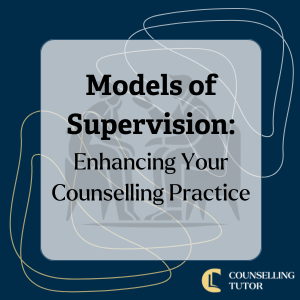
Supervision is vital for professional growth, ethical accountability, and client safety. Over the past few decades, its role in counselling has evolved from informal peer support to structured frameworks. This shift underscores the importance of engaging with supervision that aligns with both the therapist’s and supervisee’s needs. For counsellors, the challenge is navigating the plethora of supervision models to find one that complements their therapeutic approach while meeting professional standards.
Models of Supervision
By the end of this guide, you’ll gain the following actionable insights:
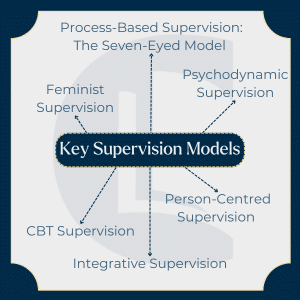
Supervision in counselling has roots in social work, gaining traction in the 1970s and 1980s through pivotal works by figures such as Joan Mattison, Brigid Proctor, and Patrick Casement. Early approaches, like co-counselling, were informal, but introducing structured models transformed supervision into a disciplined practice. Notably:

Before formal supervision became standardised, ‘co-counselling’ was common, particularly in the Rogerian tradition. Practitioners would meet informally to discuss client work and provide peer-based feedback. Although informal, this model laid the groundwork for today’s structured supervisory practices.
This model emphasises the interplay between personal and societal experiences, grounded in the principle that “the personal is political.” Feminist supervision is particularly effective when working with clients affected by systemic oppression, gender-based violence, or cultural marginalisation. It encourages supervisees and supervisors to reflect on societal power dynamics and their influence on therapeutic relationships.
Anchored in Carl Rogers’ philosophy, this approach encourages a collaborative, non-directive relationship between supervisor and supervisee. While it assumes the supervisee’s competence, it may fall short for trainees needing formative guidance. This model is ideal for practitioners who are aligned with person-centred therapy values.
Drawing on Freud’s theories, psychodynamic supervision explores transference, countertransference, and defence mechanisms. It is structured into three categories:


Cognitive Behavioural Therapy supervision focuses on structured, goal-oriented techniques. Supervisors often assign tasks like reflective homework to ensure alignment with CBT’s evidence-based framework. This model suits supervisees specialising in CBT but mismatches in therapeutic modality can lead to discord.
Integrative supervision is invaluable for eclectic therapists who combine CBT, person-centred, and psychodynamic approaches. Bernard and Goodyear’s Discrimination Model stands out. In this model, the supervisor alternates between roles as a teacher, consultant, and counsellor, depending on the supervisee’s needs.
Models of Supervision
Peter Hawkins and Robin Shohet’s widely adopted model examines supervision through seven interconnected lenses:
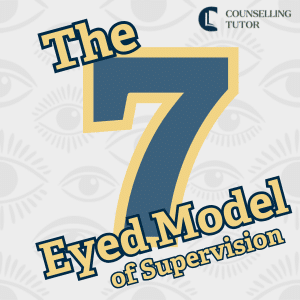
This model provides a holistic framework, encouraging reflection across multiple levels of interaction.
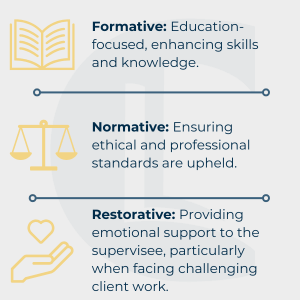
Another influential model, Proctor’s Functions of Supervision, highlights three core aspects:
Understanding the modality your supervisor specialises in is critical for productive supervision. For example, a person-centred practitioner may struggle to find value in a CBT-oriented supervisor, as their frameworks and interventions differ fundamentally. Choosing someone whose training aligns with your approach ensures a cohesive and enriching supervisory relationship.
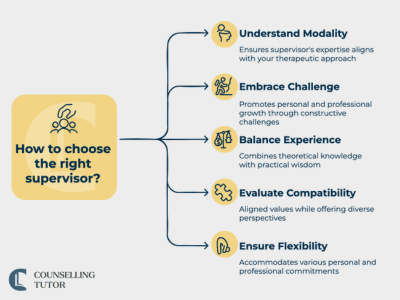
Supervision is a partnership to nurture ethical, competent, and reflective practice. To make the most of this relationship:

Supervisees may encounter challenges during sessions, such as feeling criticised or overwhelmed. It’s essential to reframe these moments as opportunities for growth. Similarly, supervisors may notice parallel processes—when supervisees unconsciously mirror their client’s behaviour—which can be explored to deepen insight and professional understanding.
Look for a supervisor whose training aligns with your therapeutic modality (e.g. CBT, psychodynamic, person‑centred), who brings both challenge and support, and whose style and availability match your growth goals and schedule.
These functions balance learning (formative), professional accountability (normative), and emotional support (restorative) – together ensuring you grow in competence while maintaining client safety and your own resilience.
The Seven‑Eyed Model (Hawkins & Shohet) encourages exploring supervision from multiple lenses – client presentation, therapist’s internal world, relational dynamics, supervisor process, and context. It’s especially helpful when supervision needs to be more reflective, systemic, and depth‑oriented.
Models of Supervision
Supervision is an evolving practice that requires intentionality and alignment with your therapeutic approach. By understanding and selecting from the myriad of supervision models available, you can create a supervisory experience that enriches your practice and ensures the best outcomes for your clients. Remember, supervision is not just a professional requirement—it’s a space for growth, learning, and connection.
Don’t forget the importance of documenting your CPD hours. Keeping a record fulfills ethical and professional requirements, and demonstrates your commitment to growth.
Proctor, B. (1986). Functions of Supervision.
Casement, P. (1985). On Learning from the Patient.
Hawkins, P., & Shohet, R. (1989). Supervision in the Helping Professions.
Feminist Therapy Institute. (1999). Feminist Therapy Guidelines.
Counselling Tutor provides trusted resources for counselling students and qualified practitioners. Our expert-led articles, study guides, and CPD resources are designed to support your growth, confidence, and professional development.
👉 Meet the team behind Counselling Tutor
Notice any broken link or issues with this resource? Kindly let us know by email
Email us